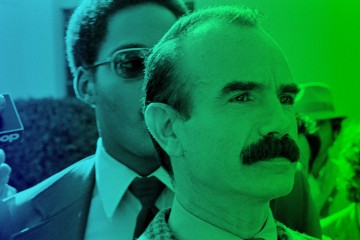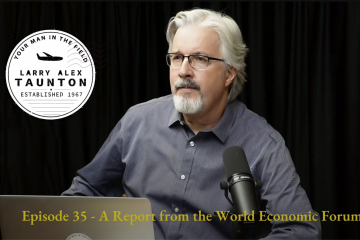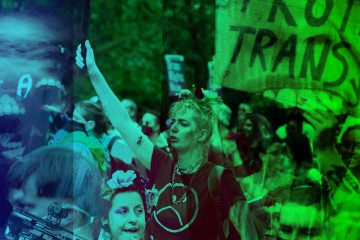New developments in the famous banana duct taped to the wall. It turns out that the fruit in question was actually a fraud.
Little did last Friday’s afternoon onlookers at the Gallery of the prestigious Art Basel in Miami know that “The Comedian,” created by world-renowned Italian artist Maurizio Cattelan, was actually a clever forgery. But as Bertlim Roubh of Homeland Security’s Cultural Property, Art and Antiquities Investigation unit told the distraught Gallery audience on Sunday evening, “This was clearly not the original banana, or duct tape for that matter, although we are fairly certain that this is the original wall. We will keep the public updated, as the investigation continues.”
While the gallery has taken down the exhibit, due to overzealous frugivores crowding the now-famous artwork, the real mystery is only beginning. Who substituted the fake fruit, and where is the original?
Cattelan’s bona fide taped banana recently sold for $120,000 (£91,352), with another version of the masterpiece expected to fetch upwards of $150,000 (£114,190). But now that the counterfeit has been discovered, the art world has been thrown into somewhat of a turmoil, given the surprising ease with which such artwork can be forged and the originals sold on the black produce market.
Suspicions about a possible forgery began on mid-Thursday afternoon, December 5th. The Gallery’s security cameras picked up what appeared to be a man in a grey trench coat hurrying away from Cattelan’s masterpiece with a small brown lunch bag. Security immediately checked the exhibit, but what they assumed to be the original banana in the exhibit appeared to be undisturbed.
However, Emmanuel Perrotin, from world-famous Perrotin’s Parisian Gallery who handled the sale, was not convinced. Perrotin, who had flown in to Miami as master of ceremonies for the unveiling of “The Comedian,” believed that the brown spots simply were not right.
Not wanting to alarm art patrons until the artwork had been tested for authenticity, Homeland’s CPAAI called in Reginald Wimsmellen, an adhesion fruit expert from Sotheby’s of London. Wimsmellen arrived late Saturday night after the gallery was closed to inspect the exhibit’s authenticity.
Wimsmellen himself was almost fooled. “In these cases, only an expert can tell the difference, and even then,” lamented Wimsmellen, “who knows how much fraudulent fruit now floods the art world?” When asked what his estimation of the caliber of the forger’s work, Wimsmellen replied, “I’d say what we have here, is someone of the level of [Wolfgang] Beltracchi or perhaps even [John] Myatt. The attention to detail in the peel and the Dole sticker are beyond anything I’ve seen—and I’ve seen a cornucopia’s worth of fake fruit.” Beltracchi and Myatt were two of the most notorious and efficient art forgers of the 20th century.
In the two photos below—the real “Comedian” on the left and the forgery on the right—the arrows point to the areas where extremely slight discrepancies were discernable by the expert eye of Wimsmellen. Note the subtle differences in shading in the brown spots of the real McCoy vs the more dull, and one might say “uninspired,” spots on the fraudulent banana.
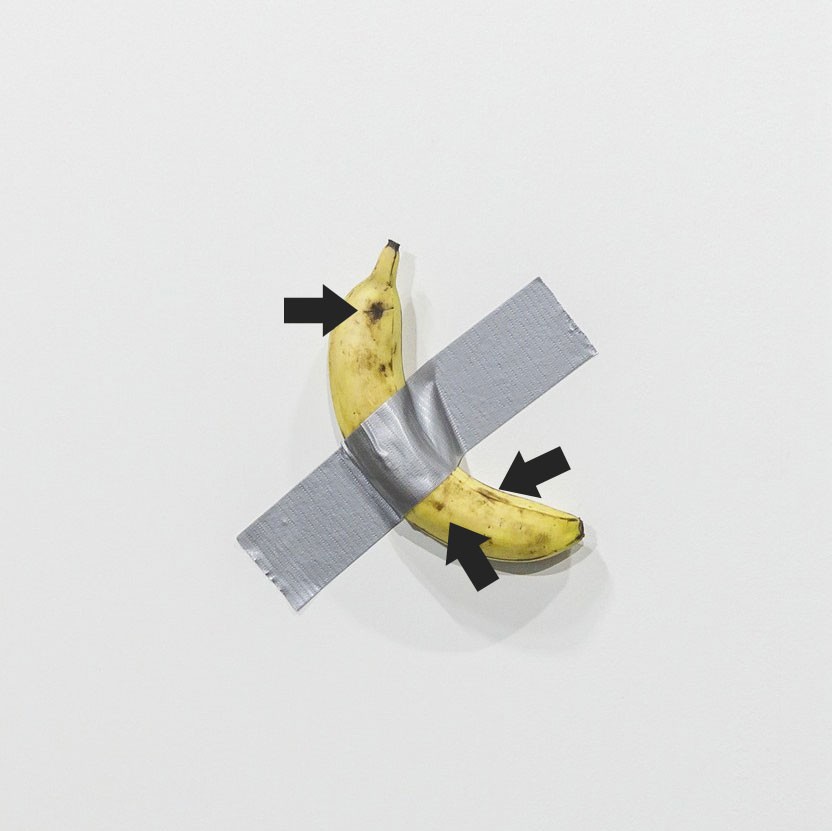
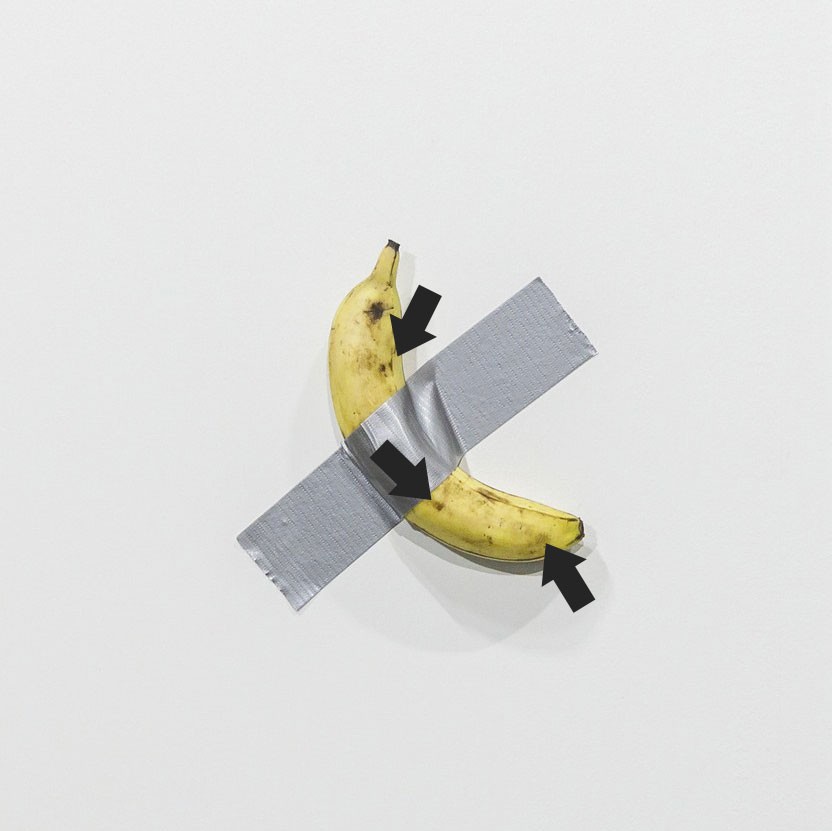
This is not the first time that Italian artist Maurizio Cattelan has suffered at the hands of the art underworld. In 2016 Cattelan’s famous golden toilet, entitled “America,” was stolen soon after it went on display at Blenheim Palace. It was rumored that thieves posing as plumbers removed the toilet which, given the traffic at the exhibition, had become clogged after having been inadvertently used by a patron who was colorblind. “America” was valued at $1,000,000 (£761,270), considerably more than the banana taped to the wall, without factoring in that the initial outlay for Cattelan’s banana was, perhaps, 12 cents (£.091)
As has been widely (and erroneously) reported, performance artist David Datuna snatched the duct-taped banana off the wall Saturday and consumed it. Unbeknownst to Datuna, the banana he ate was not, in fact, the original, but a serviceable duplicate provided by a custodial services employee from his lunch while the forgery was being held for further examination. Datuna will still be charged on the basis of malicious intent, given his reckless and destructive actions in regard to what he believed to be the original banana.
In part, the gallery’s decision to discontinue the popular exhibit was due to performance art imitators of Datuna, who realized that little native talent was needed to duplicate his performance piece, which he entitled “Hungry Artist.”
The situation has caused another set of worries in the art world similar to that caused by the forgery of “The Comedian”—how can a real performance artist be distinguished from a clever forgery? Just last January performance artist Minely Flindersock’s presentation, “Shopping Neuroses,” which consisted of him wandering around Walmart wearing his pajamas, was missed entirely as the cameras followed an actual patron of the store by mistake. Flindersock still received his $240,000 (£182,543) award from the National Endowment of the Arts, claiming that the mistake was part of the performance, adding yet another layer of existential depth.
Back to our lead story, investigators continue to seek clues—and with some urgency, given that the original banana will undergo significant enzymatic browning in this coming week. Those who believe they may have pertinent information are urged to fill out the form on the CPAAI’s website.
WAIT! Do you appreciate the content of this website? We are a nonprofit. That means that our work is made possible and our staff is paid by your contributions. We ask you to consider supporting this important work in an ongoing basis or, if you prefer, perhaps you will drop a few buck in our “tip jar.” All contributions are tax-deductible.
